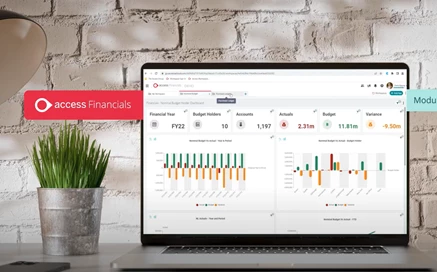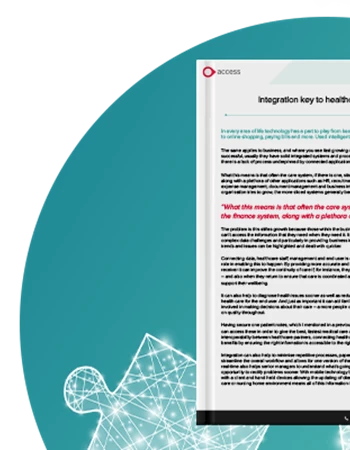
How you can solve the 3 largest issues finance mangers face in the care sector
There is plenty for care sector finance managers to contend with at the moment – from fluctuating service user numbers and staffing levels to inconsistent revenue streams which make cashflow difficult to predict. Here's how to solve these issues.
 5 minutes
5 minutes
Written by The Access Group
There is plenty for care sector finance managers to contend with at the moment – from fluctuating service user numbers and staffing levels to inconsistent revenue streams which make cash flow difficult to predict.
Ultimately all of these pressing problems need solutions – and the latest technology offers some useful and effective ways to help finance managers alleviate their day-to-day stresses and make their teams more efficient and productive. It’s also not as complex or expensive as you might think…
Issue 1: Unpredictable cash flow
For many care providers this has always been an issue. For example, it’s often necessary to provide care and support quickly, yet it can take a while for assets to be liquidated and payment plans to kick in; and government and local council budgets are also under pressure which makes funding difficult to access in some cases.
Even those finance managers who had a ‘buffer’ to help alleviate income fluctuations will have found some difficulties in recent months when the pandemic put extra strain on cash flow and meant unforeseen expenses such as additional protective clothing and cleaning supplies were required.
Solution: More accurate cash flow analysis and predictive modelling
What finance managers can do is make use of the latest data analysis and modelling tools to create a better overall picture of cash flow. The right tools can give real insight and allow you to adjust variables and build flexible ‘what if’ scenarios to support financial decision-making.
For example, by analysing past patient duration data, financial software can help you to model what future patient stays might look like from a revenue perspective over the longer term.
Issue 2: High levels of staff turnover
Turnover is a widespread problem for the care sector with levels in the UK at around 30% in 2019. Recruiting suitable staff then also becomes an issue and in England the average vacancy rate is 7.8% (Source: Skills for Care Workforce Estimates 2018/2019).
Finance heads are well aware that there are various factors behind these top level statistics including low wages, long hours, perceived negativity around some aspects of the work, and high levels of geographic mobility. But there are some actions that can be taken to help to address these problems.
Solution: Use integrated data and insight to create more robust retention strategies
Firstly, integrating data gives far better insight into the specifics behind staff turnover. For example measuring employee engagement and cross-analysing it with salary levels, length of time employed and other factors makes it possible to adopt an evidence-based approach for targeted salary rises or responsive employee wellbeing schemes which are more likely to have the desired effect.
Data analysis and insight is also a useful way to assess use of temporary staff, the associated costs, and the impact on turnover. Gathering data on engagement and productivity of temporary staff can even reveal how this strategy is affecting your permanent workforce and your overall turnover rates.
Issue 3: Inaccurate and time-consuming data entry and admin
The finance function can be faced with a significant amount of rekeying of data – from processing hours for payroll to wading through travel and expenses claims. The problem here is that reliance on paper records and manual processes makes it easy for errors to creep in; it’s also slow and inefficient.
Solution: Easy-to-use technology plus automation tools
A finance system that is designed to deal with the specific functions required in a care setting – such as variable invoicing and changing hours and shifts for staff – can make life much easier for your staff.
This type of modern system has the tools you need already included and will automate and speed up much of the time-consuming work that is done manually. That in turn gives finance professionals more time to spend on value-adding activities.
As well as reducing the admin burden via automated processing, finance technology also opens up a whole new world of management reporting through the use of integrated data.
This provides the evidence needed to understand productivity and identify and resolve inefficiencies. It could be that your business is losing cash in onboarding costs due to preventable staff turnover, for example.
Ultimately, a more up-to-date and integrated finance system ensures consistent and verifiable data is available to the C-suite, the finance team and other key managers involved in decision-making.
Now is the time to make choices which will optimise your revenue cycle – whether that’s investing in data tools that help to identify savings opportunities or simply automating as many processes as possible to cut out waste.
Explore resources

The challenges faced by finance teams in care organisations
Get an insight into the world of health and social care and discuss key challenges care organisations are facing and how to solve them with the right technology.

Get your guide to finance transformation in the care sector
Why digital transformation is necessary for care providers.

Increase revenue and reduce costs with an integrated management platform
How an integrated financial and care platform can give you a single version of the truth enabling better compliance, reduced costs and increased profitability.
Explore further
Discover more resources on finance automation and integration in care.










